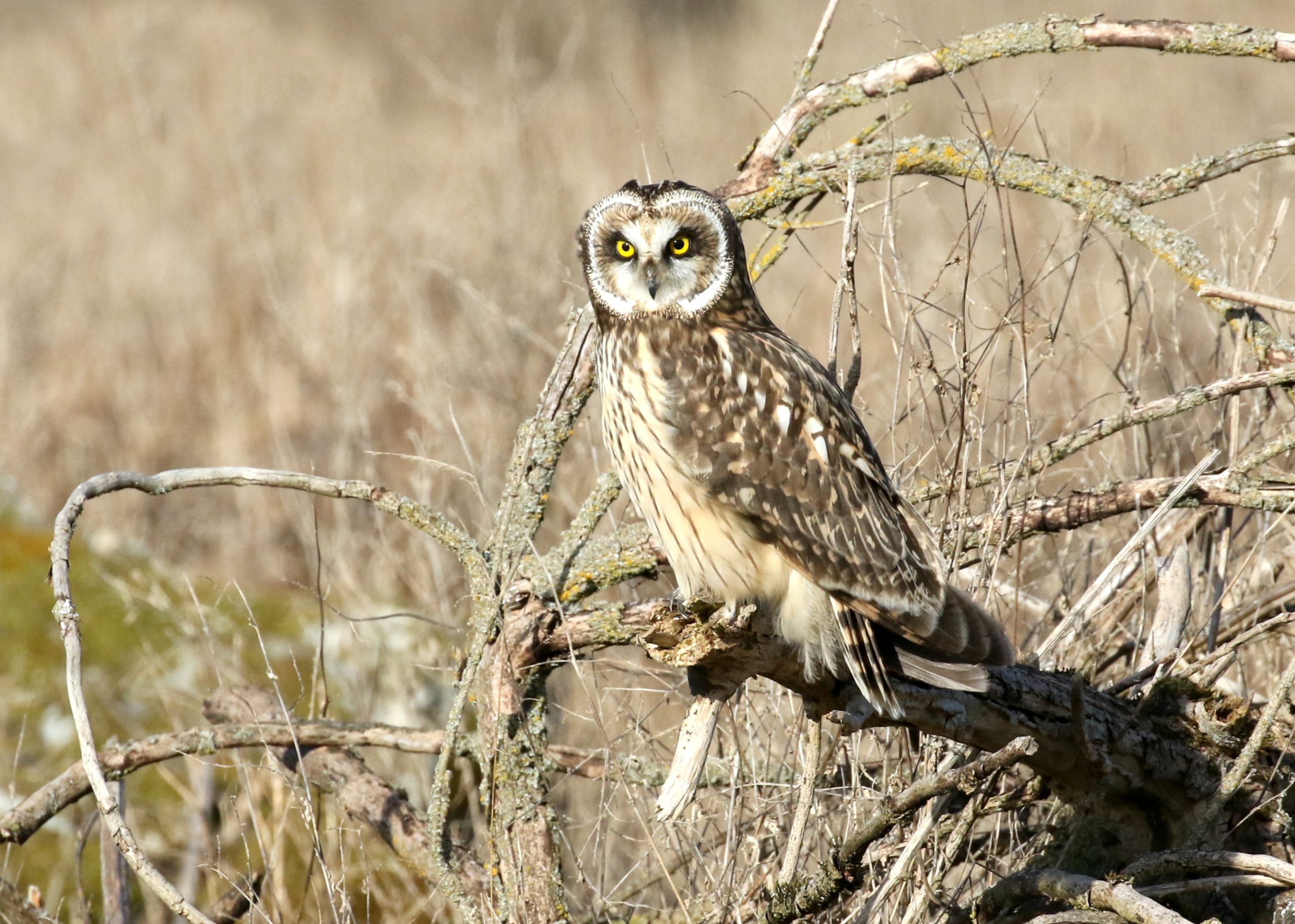In Our Backyard: Short-eared Owl

The short-eared owl (Asio flammeus), with its streaked brown plumage and piercing yellow eyes, is a charismatic raptor of the Thompson-Nicola region. Unlike most owls, it is frequently active in daylight, often gliding low over grasslands in a buoyant, moth-like flight as it searches for prey. This unusual behavior makes it one of the most visible and recognizable owls in our open landscapes.
Medium-sized with a wingspan close to one metre, the short-eared owl takes its name from the small feather tufts on its head, though these “ears” are usually hard to see. Its round facial disk gives it a startled look, while its long wings and agile flight set it apart from other grassland birds of prey.
Distribution
In British Columbia, short-eared owls are widely distributed but patchy, as they depend on open habitats such as native grasslands, marshes, shrub-steppe, and agricultural fields. In the Thompson-Nicola, they are most often seen in bunchgrass ecosystems or hayfields, where their ground-nesting habits and cryptic colouring make them difficult to spot when resting.
Highly nomadic, these owls follow fluctuations in small mammal populations, particularly voles. In years when prey is abundant, they may appear in significant numbers, while in lean years they can be nearly absent. This dependence on prey cycles makes their presence both unpredictable and special—a reminder of the delicate balance within grassland ecosystems.
Threats
Across North America, short-eared owl populations are in decline due to multiple, converging threats. Data from both the Breeding Bird Survey and Christmas Bird Counts indicate a decline of more than 30% over the past three generations.
Conservation Status in Canada:
-
COSEWIC Status: Threatened (May 2021)
-
SARA Schedule 1 Listing: Special Concern (July 2012)
Provincial Status (BC):
-
BC CDC: Blue-listed (Special Concern)
Note: While COSEWIC recognizes this species as Threatened based on current science, its federal legal designation under SARA is still Special Concern, which may affect the level of legal protection and recovery planning.
Habitat loss and degradation are primary concerns. Grasslands and wetlands, already some of the most endangered ecosystems in the province, continue to be lost to agriculture, development, and industrial activity. With fewer open spaces available, nesting and foraging opportunities are diminished.
Because they nest directly on the ground, short-eared owls are also vulnerable to disturbance. Haying, grazing, and recreational activities can easily destroy eggs or chicks hidden among grasses. Even minor disruptions may cause adults to abandon nesting sites.
Predation by mammals and corvids is a natural challenge, but increasing pressure from larger raptors such as red-tailed hawks or great horned owls can further limit nesting success. Climate change compounds these stresses, as shifting precipitation and vegetation patterns alter vole populations, and more frequent drought and wildfire events fragment the grasslands owls rely upon.
Conservation
Conservation initiatives for short-eared owls in the Thompson-Nicola focus on maintaining and restoring open landscapes. Protecting native grasslands, shrub-steppe, and wetlands is critical, as is working with farmers and ranchers to adopt wildlife-friendly practices. Delaying haying operations until after the nesting season and managing grazing intensity can help safeguard ground nests.
Wetland and riparian conservation also plays a key role, supporting healthy small mammal populations that sustain owls. Community science programs, such as local bird surveys, provide valuable data on population trends and help raise awareness about the challenges these owls face.
At the provincial level, land-use planning that integrates ecological corridors and safeguards against further grassland loss is essential. By conserving habitat for the short-eared owl , we also protect a rich array of grassland-dependent wildlife, reinforcing the health and resilience of the Thompson-Nicola’s ecosystems.
Learn More
- COSEWIC Assessment and Status Report: Short-eared Owl (Asio flammeus)
- BC Species and Ecosystems Explorer: Short-eared Owl
- Birds Canada – Nocturnal Owl Survey
- eBird – Short-eared Owl (recording)
Feature image: Short-eared owl by Tim McKibben (CC by NC 2.O) via iNaturalist
